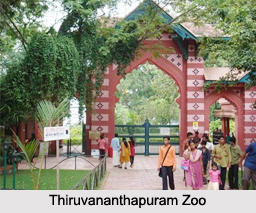 Zoos of Southern India deal with zoos of the states of Tamil Nadu, Kerala, Karnataka, Andhra Pradesh and Telangana. These zoos add value to the tourism of the South Indian states and therefore can be regarded as their tourism product.
Zoos of Southern India deal with zoos of the states of Tamil Nadu, Kerala, Karnataka, Andhra Pradesh and Telangana. These zoos add value to the tourism of the South Indian states and therefore can be regarded as their tourism product.
Zoos of Tamil Nadu
Arignar Anna Zoologial Park is regarded as the largest zoo in India, occupying about 1,300 acres of land. Amirthi Zoological Park is located in Tiruvannamalai District of Tamil Nadu. It was opened in the year 1967. This zoological park is spread over a land of about 25 hectares and its noteworthy aspects are waterfalls. Salem Kurumampatti Zoo, Anand Angus Zoo, Crocodile Bank, Deer Park, Snake Park and VOC Park and Zoo are also located in Tamil Nadu.
Zoos of Kerala
Kerala serves as a home to the oldest zoo in India and Asia namely, Thiruvananthapuram Zoo. This zoo which is located in Thiruvananthapuram was opened in 1857. It is spread over an area of about 55 acres. The state government of Kerala is responsible for the renovation of Thiruvananthapuram Zoo and financial and technical help for this purpose would be provided by the Central Zoo Authority. Another old zoo in Kerala is Thrissur Zoo. It is located in Thrissur and was opened in 1885. Kodanadu Mini Zoo is also located in Kerala.
Zoos of Karnataka
Karnataka houses one of the oldest and popular zoos in India, namely Mysore Zoo. It is located near a palace in Mysore. Spreading over a land of about 245 acres (99 ha), this zoo is regarded as the 6th largest zoo in India. Apart from Mysore Zoo, Karnataka also houses the Bellary Zoo and Bannerghatta Biological Park.
Zoos of Andhra Pradesh
Indira Gandhi Zoological Park is located amidst Kambalakonda Reserve Forest in Visakhapatnam, Andhra Pradesh. It is regarded as the 3rd largest zoo in India. It was opened in 1977and occupies about 625 acres of land. Animals in Andhra Pradesh are also sheltered in Sri Venkateswara Zoological Park. This zoological park is located in Tirupati and was opened in 1987. It is spread over 5,532 acres of land. Mayuravani (house for peafowl), Mrugavani (house for herbivores) and Vrukavihar are its noteworthy aspects.
Zoos of Telangana
Nehru Zoological Park is housed in Hyderabad in Telangana. It was opened on 6th of October, 1963 and is spread over an area of about 380 acres. Telangana also houses a zoo named Warangal Zoo. It is located in Hanamkonda, Warangal and was opened in 1985. It is spread over 50 acres of land.















